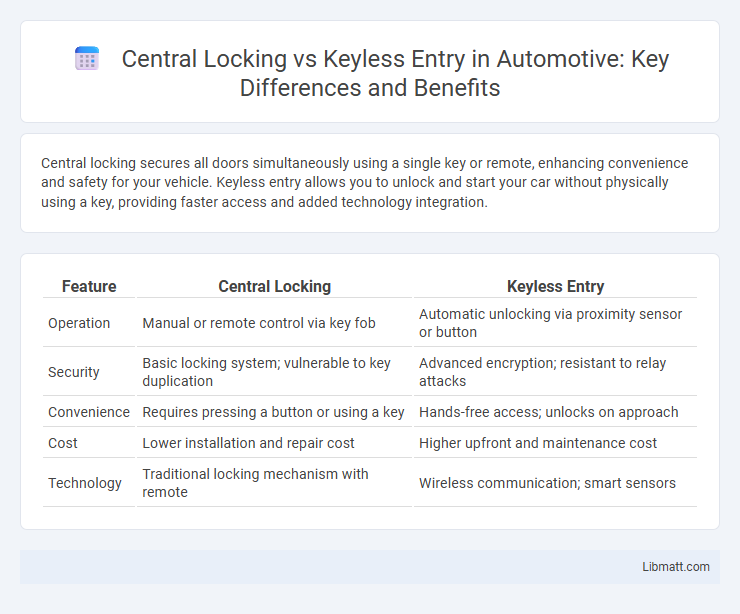Central locking secures all doors simultaneously using a single key or remote, enhancing convenience and safety for your vehicle. Keyless entry allows you to unlock and start your car without physically using a key, providing faster access and added technology integration.
Table of Comparison
| Feature | Central Locking | Keyless Entry |
|---|---|---|
| Operation | Manual or remote control via key fob | Automatic unlocking via proximity sensor or button |
| Security | Basic locking system; vulnerable to key duplication | Advanced encryption; resistant to relay attacks |
| Convenience | Requires pressing a button or using a key | Hands-free access; unlocks on approach |
| Cost | Lower installation and repair cost | Higher upfront and maintenance cost |
| Technology | Traditional locking mechanism with remote | Wireless communication; smart sensors |
Introduction to Vehicle Access Systems
Central locking systems secure all vehicle doors simultaneously using a physical key or remote control, providing basic protection and convenience. Keyless entry offers advanced access through proximity sensors or smartphone apps, enhancing user experience by eliminating the need to physically handle keys. Your choice between these systems impacts convenience, security features, and integration with modern smart technologies.
What is Central Locking?
Central locking is a vehicle security system that allows you to lock or unlock all doors simultaneously using a single control, typically a key fob or a switch inside the car. It enhances convenience and safety by preventing unauthorized access and enabling quick securing of the entire vehicle. Your car's central locking system integrates electronic actuators within each door, ensuring synchronized operation with just one command.
What is Keyless Entry?
Keyless entry is an advanced vehicle access system that uses electronic signals to lock and unlock car doors without physically inserting a key. It typically operates via a key fob or smartphone app, allowing users to unlock their car remotely or automatically when they approach. This technology enhances convenience and security by eliminating the need for manual key use and reducing the risk of lost or stolen keys.
Key Features of Central Locking Systems
Central locking systems enable simultaneous locking or unlocking of all doors through a single switch or remote, enhancing convenience and security. These systems often integrate with alarm systems, providing an automatic safety response when doors are locked. Reliability and ease of installation make central locking a popular choice in many vehicle models worldwide.
Key Features of Keyless Entry Systems
Keyless entry systems offer enhanced convenience by allowing vehicle access without physically inserting a key, using proximity sensors or remote fobs to unlock doors automatically. These systems often include rolling code encryption for improved security against hacking attempts and can integrate with smartphone apps for remote monitoring and control. Key features typically encompass keyless start capabilities, customizable settings, and emergency mechanical key overrides to ensure access in all situations.
Security Comparison: Central Locking vs Keyless Entry
Central locking systems provide reliable security by mechanically locking all doors simultaneously, reducing the risk of leaving any door unsecured. Keyless entry enhances security with encrypted electronic signals and rolling codes that are difficult to clone, lowering the chance of unauthorized access. Vulnerabilities in keyless entry systems include relay attacks, while central locking systems depend on physical key security and vehicle immobilizers for protection.
Convenience and User Experience
Central locking offers a straightforward and reliable way to secure all doors simultaneously using a traditional key or remote, providing a familiar user experience. Keyless entry enhances convenience by allowing you to unlock your vehicle with a proximity sensor or smartphone app, eliminating the need to physically handle keys. This seamless access improves efficiency and comfort, especially in situations where your hands are full or quick entry is essential.
Installation and Maintenance Differences
Central locking systems require wiring installation within car doors, often needing professional expertise to integrate with existing mechanical locks, while keyless entry systems rely on electronic components like sensors and remote fobs, demanding more complex programming and synchronization. Maintenance for central locking tends to focus on mechanical parts such as actuators and switches, whereas keyless entry maintenance involves battery replacements and troubleshooting wireless connectivity issues. Keyless entry systems may incur higher repair costs due to their advanced technology and dependency on electronic modules.
Cost and Value Considerations
Central locking systems generally offer a lower initial cost compared to keyless entry, making them a budget-friendly option for basic vehicle security. Keyless entry provides added convenience and enhanced security features, which can increase your vehicle's value and justify the higher investment over time. Evaluating your priorities in cost versus long-term value helps determine the best choice for your specific needs.
Which Access System is Right for You?
Central locking systems provide traditional key-operated control for all doors, offering simplicity and reliability ideal for users seeking straightforward security without extra features. Keyless entry systems use remote controls or smartphone apps to unlock doors without physical keys, enhancing convenience and allowing features like remote access and integration with smart home devices. Choosing between central locking and keyless entry depends on preferences for ease of use, security requirements, and technological comfort, with keyless entry favored for modern connectivity and central locking valued for dependable mechanical operation.
central locking vs keyless entry Infographic

 libmatt.com
libmatt.com